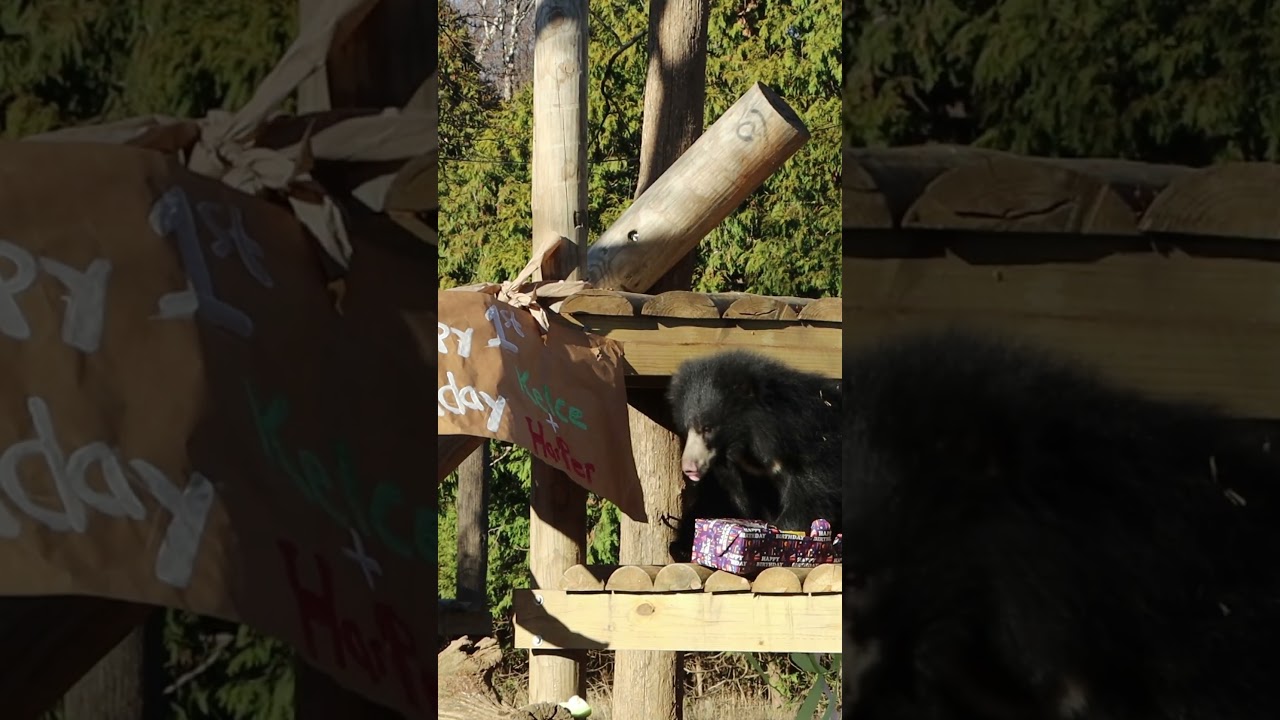– The joyous celebration of Kelce and Harper’s first birthday highlights the significance of conservation efforts for sloth bears.
– Exploring the natural behaviors and development milestones of sloth bear cubs in their first year.
– Ways enrichment and special events like birthdays enhance the well-being of animals under human care.
– The vital role of species like the sloth bear in their ecosystems and how conservation initiatives contribute to preserving biodiversity.
Time flies when you’re climbing trees and munching on fruit! It seems like just yesterday that two bundles of fur arrived into the world, opening their eyes to the wonders of a life they would soon explore. Now, we’re tipping our hats and blowing our party horns in honor of a very special occasion: the first birthday of Kelce and Harper, two sloth bear cubs whose adventures have captivated the hearts of many.
So, what’s all the hubbub about these furry celebrants? Beyond the adorable antics and fun-filled festivities, there’s a profound narrative unfolding—one that’s intricately woven into the larger tapestry of wildlife conservation. You see, in a world where the loss of species has become all too familiar, every birth in the wild or under the devoted care of conservation professionals is a beacon of hope, a testament to the enduring spirit of life on this planet, and a reminder of the responsibilities we share in safeguarding our natural heritage.
To truly appreciate the merriment surrounding Kelce and Harper’s milestone, let’s delve into the unique characteristics of these captivating animals. Sloth bears (Melursus ursinus) are a nocturnal and myrmecophagous species—meaning they have a penchant for slurping up termites and ants using their formidable snouts and long, curved claws that can tear open termite mounds with precision. Their shaggy coat is not just a fashion statement; it provides a barrier against the bites of their insect prey, and in the case of our bear cubs, it also incites many an “aww” from their admiring audience.
Their early days were defined by tender moments nestled close to their mother, learning the ropes of bear-dom through play and exploring their environment with an insatiable curiosity. A cub’s development is a breathtaking journey to witness. They begin defenseless, relying completely on their mother for nutrition and protection. Yet, within months, these same cubs start to unravel the complexities of the world around them through robust play-fighting, climbing, and foraging—skills essential for survival in the wild.
As Kelce and Harper reached their first year, the once tiny, vulnerable infants transformed noticeably, showcasing increased independence and distinct personalities that enchant onlookers daily. Each act of climbing or inspection of their terrain isn’t merely a delight to observe; it’s a chapter in their lifelong learning process that equips them to tackle the challenges ahead.
The celebratory shindigs thrown by their keeper team illustrate the profound commitment to animal welfare—a fusion of jubilation and education that boosts mental and physical stimulation. Mimicking aspects of their natural behavior, the enrichment gifts serve as more than mere entertainment. These objects and puzzles stimulate their intelligence, coaxing out those innate behaviors crucial to their identity.
Amid the fun and frolic, it’s important to remember the precarious threads upon which the future of sloth bears hangs. Listed as vulnerable by the International Union for Conservation of Nature (IUCN), sloth bears face threats from habitat loss, human-wildlife conflict, and poaching. Each obstacle poses a complex challenge that demands comprehensive solutions blending education, community involvement, and scientific insight.
The survival of the seemingly playful and whimsical sloth bear is a serious business. Conserving them isn’t just about securing a future for a single species; it’s about acknowledging the interconnectedness of all life. These bears play an indispensable role in their ecosystems, acting as seed dispersers and regulators of insect populations. By ensuring their survival, we help maintain the balance of nature and uphold the integrity of myriad other life forms, including our own.
So, as we cheer for the growth and development of Kelce and Harper, we’re also raising a toast to the global efforts that sustain their wild cousins and protect the landscapes they call home. Every conservation triumph, every instance of public awareness, and every shared moment of joy strengthens the alliance between humanity and the natural world.
In the wild dance of life, where every creature’s role is pivotal, Kelce and Harper’s birthdays serve as a glittering reminder of the beauty and fragility of nature. They are sparks of light in what can sometimes feel like a dimming world, illuminating the fact that with assiduous stewardship and undying passion, we can hold back the tides of extinction and give rise to a tomorrow rich with the pitter-patter of bear cubs and the rustle of trees.
As we move forward, let’s carry the spirit of this celebration in our hearts, advocating for sustainable living and supporting those who stand on the front lines of conservation. Let the memory of the sloth bear cubs’ jubilee prompt conversations about biodiversity, inspire the next generation of conservationists, and kindle an enduring commitment to coexistence.
*****
Source Description
Wishing an incredibly HAPPY FIRST BIRTHDAY to our sloth bear cubs, Kelce and Harper!! 💚❤️ 🥳 Our keeper team gave them two birthday parties to celebrate with awesome enrichment and gifts for them to dig into. One thing is certain: decorations don’t last long at a baby bear birthday party! 🐻
Their birth and birthdays are important for the conservation of this species. The International Union for Conservation of Nature (IUCN) lists sloth bears as vulnerable.


